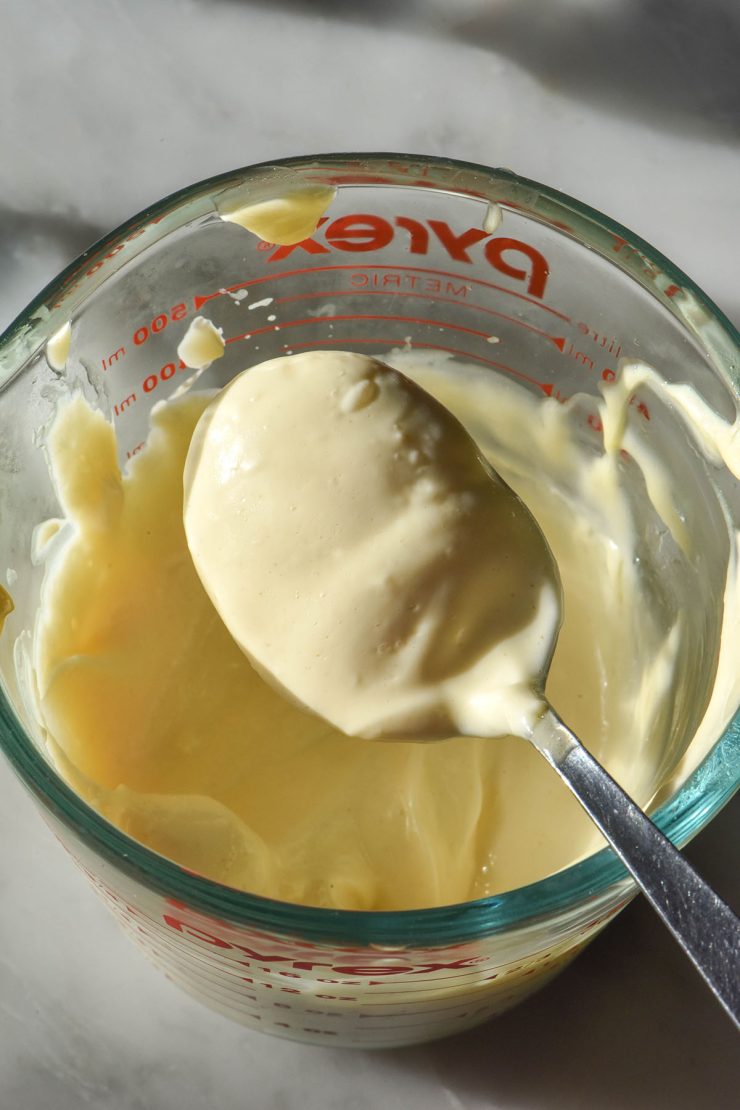
I am a mayonnaise GIRL, but I do have specific requirements for my mayonnaise. Firstly, it needs to have a short ingredients list without any suspect or high FODMAP ingredients. Secondly, it can’t be too eggy but also needs to be full of flavour. Enter: this delicious and easy low FODMAP mayonnaise recipe. It ticks all the boxes and is incredibly easy to make.
Low FODMAP mayonnaise recipe
This mayonnaise could not be easier to make and comes together with very simple ingredients. All you need is a clean pouring jug or glass and an immersion blender (at my house we call this a soup stick). It takes under a minute for the mayonnaise to come together – no slow pouring of oil and hoping for an emulsion. It really is the best way to make mayonnaise and is the only way I make it these days.
This easy low FODMAP mayonnaise is gluten free, grain free, dairy free and nut free. It is also SIBO friendly as it doesn’t contain any sugars or weird ingredients you often find in store bought mayonnaise.
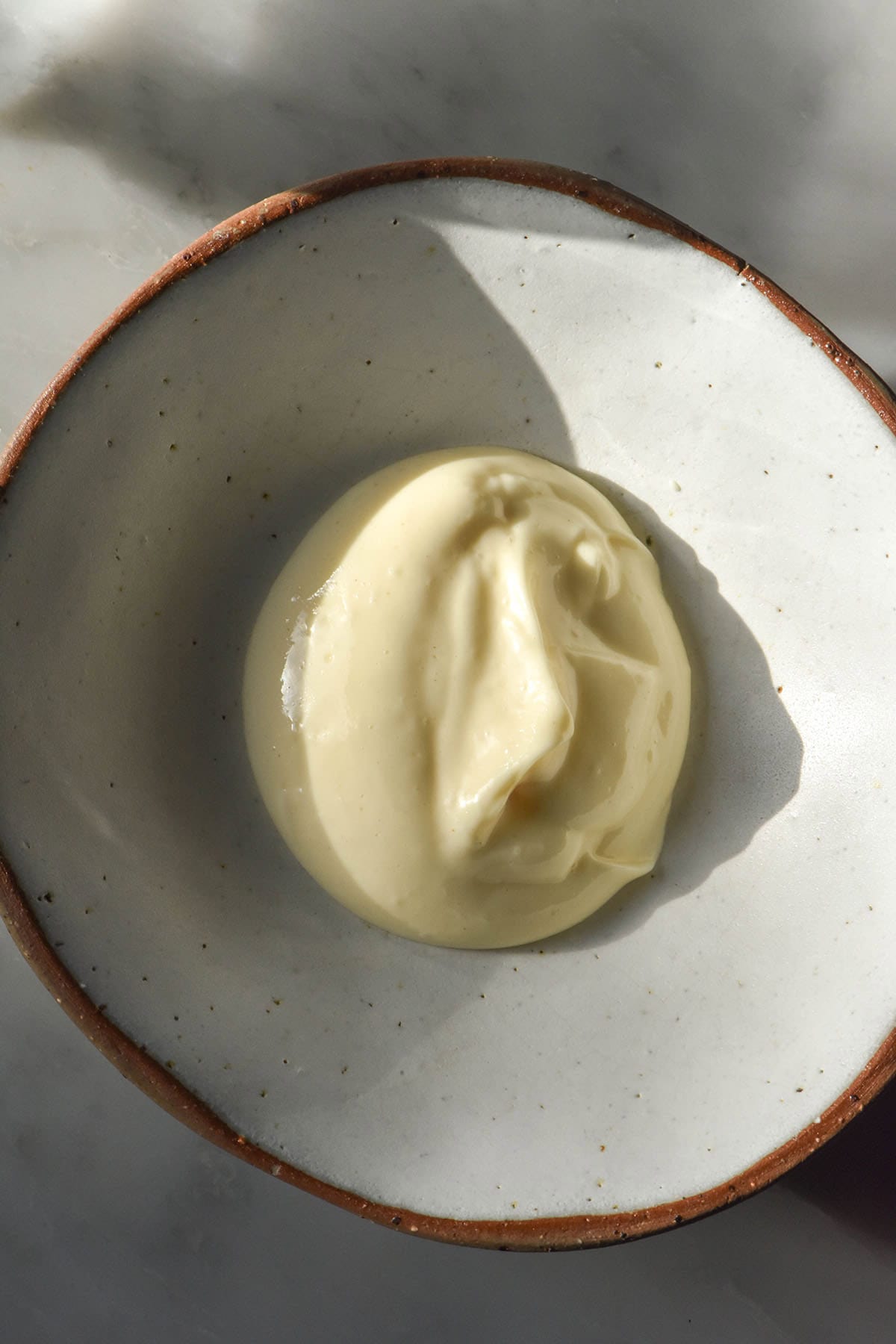
Ingredient notes
The most important note for this mayonnaise is in relation to the oil. I see a lot online about how seed oils are bad etc etc – I’m not getting into that here. What I do know is a neutral oil like vegetable oil is critical for a mayonnaise that tastes like mayonnaise.
Although I have attempted mayonnaise making with more neutral olive oil, it doesn’t pass muster to me. The result is still olive tasting and not mayonnaise tasting. You can do what works best for you and what you prefer, but just know that I highly recommend using a really neutral oil here.
I see a lot of avocado oil based mayonnaise on the market so that might be one to try. Personally I haven’t tested it, but from what I can tell the refined version is supposed to be quite neutral in taste.
In Australia, eggs are generally quite safe to consume raw. In some countries, eggs are washed prior to being sold, which leaves them without their protective coating and more at risk of salmonella and other issues. If you live in a country where this occurs, use pasteurised eggs. Also, consider buying a vegan mayonnaise if you have a compromised immune system and eggs might present a risk to you.
To an extent, the egg you use will change the colour of your mayonnaise. Using an egg with a bright orange yolk will make a slightly more vibrant mayonnaise, while a pale yolk will be more subtle.
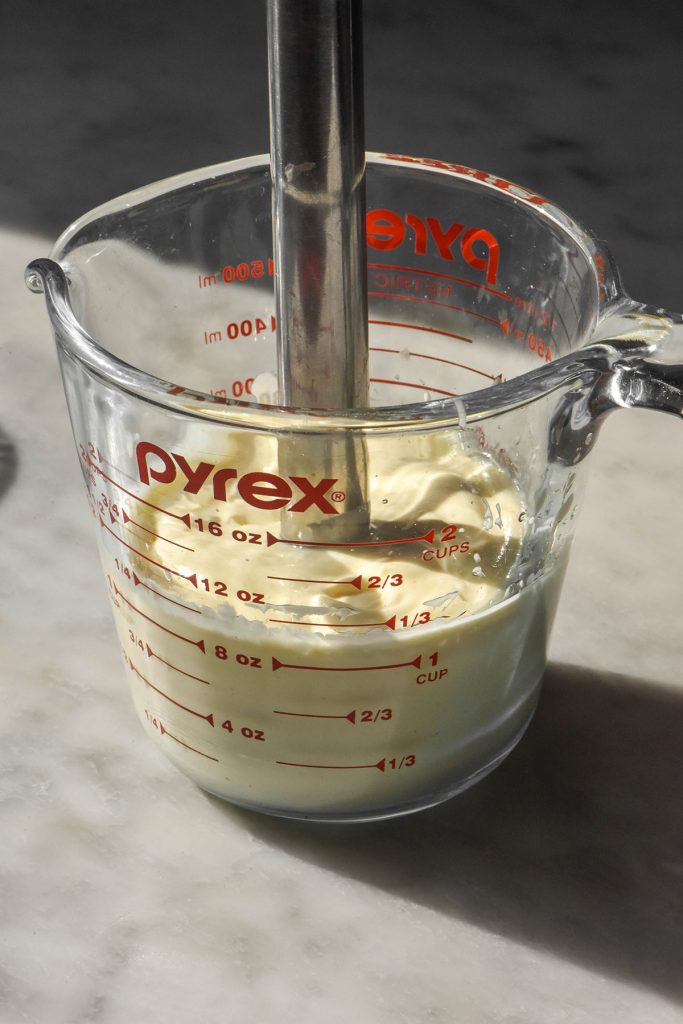
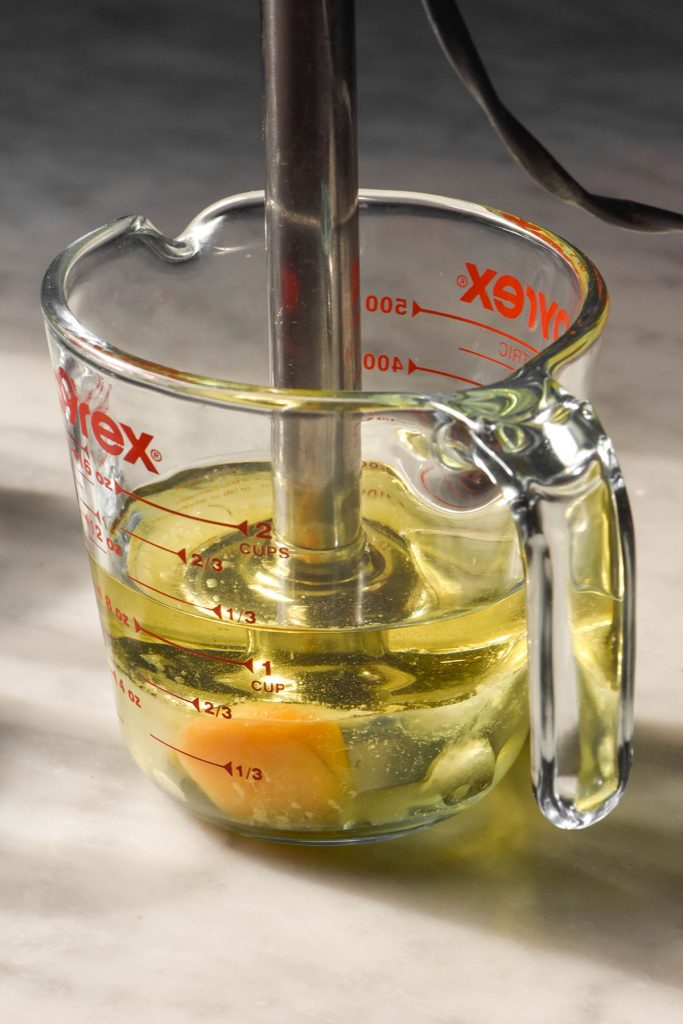
How to make immersion blender mayonnaise
Immersion blender mayonnaise is the easiest mayonnaise to make, hands down. You need a jar or pouring jug with a small, flat base so that the immersion blender can blend all of the ingredients. A large, shallow bowl won’t cut it here – I use a Pyrex measuring jug and it is perfect for this purpose.
To make the mayonnaise, simply add the egg, a conservative amount of mustard and lemon juice, the salt and the oil to your jug. Allow everything to settle for a minute or two – the oil should be in a layer on top.
Place the immersion blender flush against the bottom of the jug and start to blend. Keep it at the bottom of the jug until the mixture at the bottom begins to turn milky and creamy (mayo consistency, dare I say).
From here, slowly pull the immersion blender up the jug as you blend. The mixture should all emulsify, resulting in a pale and creamy mayonnaise. Continue to blend up and down the jug until there is no oily film on the top and you are happy with the consistency.
From here, you can taste and adjust your mayonnaise as needed. That’s it! The easiest, least stressful mayonnaise you’ll ever make.
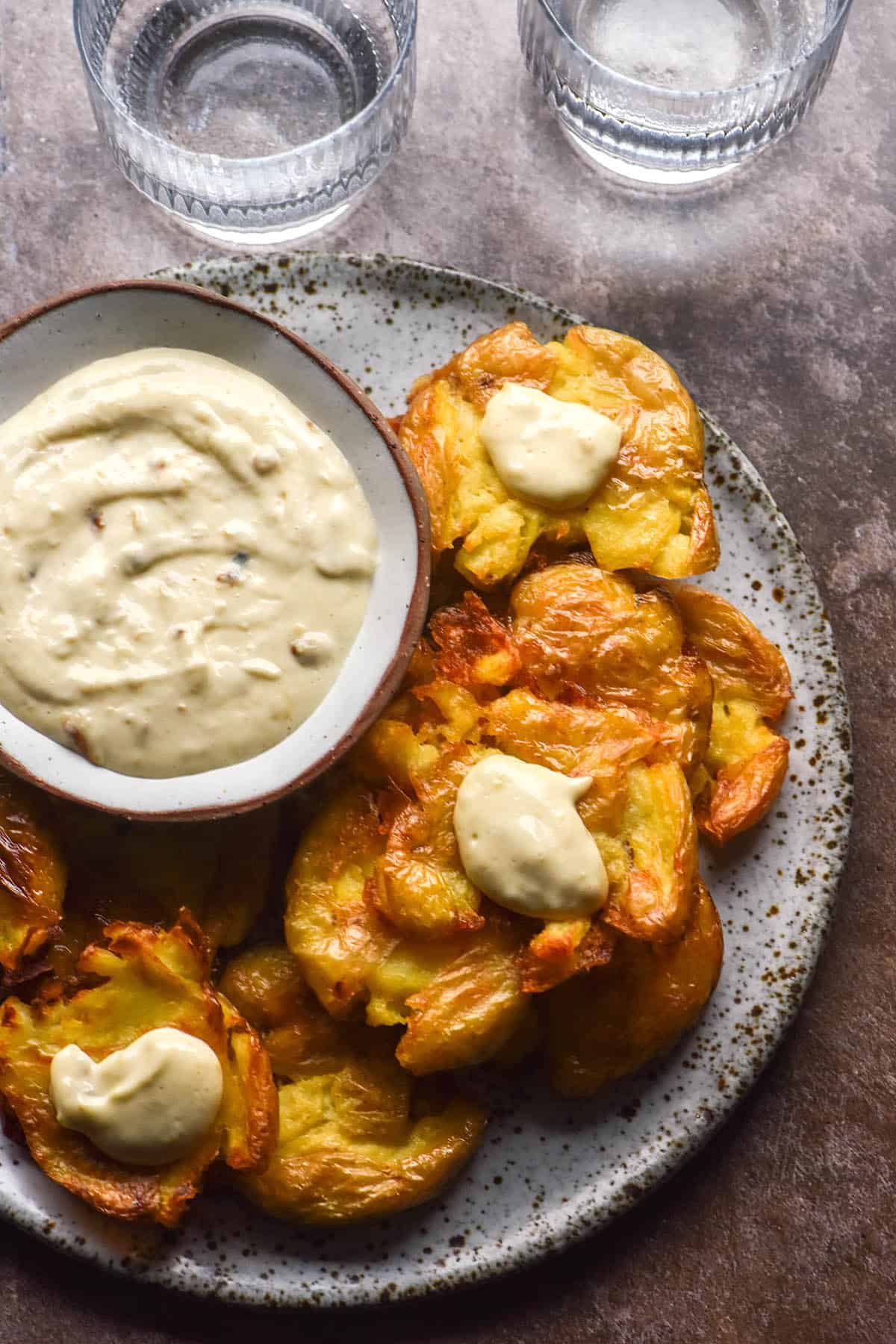
Uses for your low FODMAP mayonnaise
- Low FODMAP blue cheese dip
- Low FODMAP roasted garlic aioli
- Low FODMAP French onion dip
- Low FODMAP Tunacado
- Low FODMAP vegetarian Caesar salad
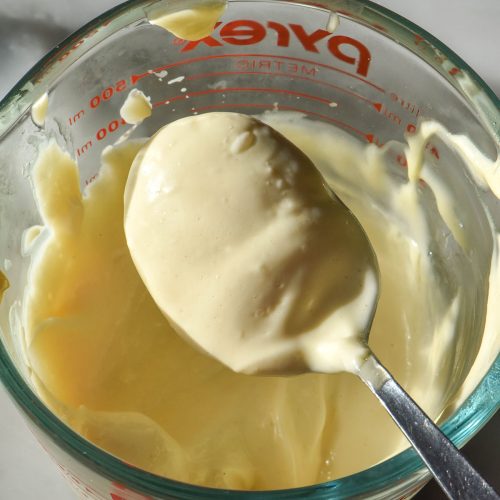
Low FODMAP mayonnaise recipe
Ingredients
- 1 extra large egg (45-55g, weighed out of shell)
- 1-2 teaspoons dijon mustard, to your tastes
- 1-4 teaspoons fresh lemon juice, to your taste (see notes)
- 3.5g (1/2 teaspoon) fine table salt, to your tastes
- 180ml (3/4 cup)* neutral oil (I use vegetable, see notes)
Instructions
- Add the egg, 1 teaspoon of dijon mustard, 1 teaspoon of lemon juice and salt to the bottom of a measuring jug or sturdy jug with a small base (wide enough for the immersion blender).
- Add the oil and allow the mixture to sit and settle for a few minutes.
- Place your immersion blender in the base of the jug, flush with the bottom. Begin blending as you hold the immersion blender flush with the base of the jug. After a little while, the mixture in the bottom of the jug will become milky and thicker – mayonnaise like in consistency (of course!).
- Slowly begin bringing the immersion blender up the jug as you continue to blend. Quite quickly, the entirety of the mixture should have emulsified into a spoonable mayonnaise consistency. Continue to blend until there is no oily layer on top of the emulsified mayonnaise.
- Taste and adjust your mayonnaise according to your preferences. You can use the immersion blender to add flavourings in, but I prefer to use a spoon at this point.
- Use your mayonnaise wherever you plan to. Store leftovers in an airtight container in the fridge.
- Use your homemade mayonnaise within about a week to be on the safe side. Some people are happy to go longer but I recommend a week maximum. I have never had mayonnaise last longer in my house because it's always eaten long before then!
Notes
- I cannot get around a mayonnaise made with mild olive oil. It still tastes like olive oil and ruins the flavour, in my opinion. I highly recommend a super neutral oil like vegetable, canola or rapeseed. You might be able to try refined avocado oil but I haven’t tested the theory. I’m not going to get into the health side of seed oils here.
- Use a dijon mustard that doesn’t contain onion or garlic. In Australia, I use and love Maille dijon mustard. It’s onion and garlic free but also has the best taste, in my opinion.
- Use conservative lemon and adjust accordingly. I have previously been working with Meyer lemons but tried this recipe with a regular lemon and was shocked at how potent the tang was. Use less of a sour lemon and more of a sweeter lemon (like Meyer). With that said, use it to taste.

I have used Advocado Oil for mayo and it worked fine 🙂